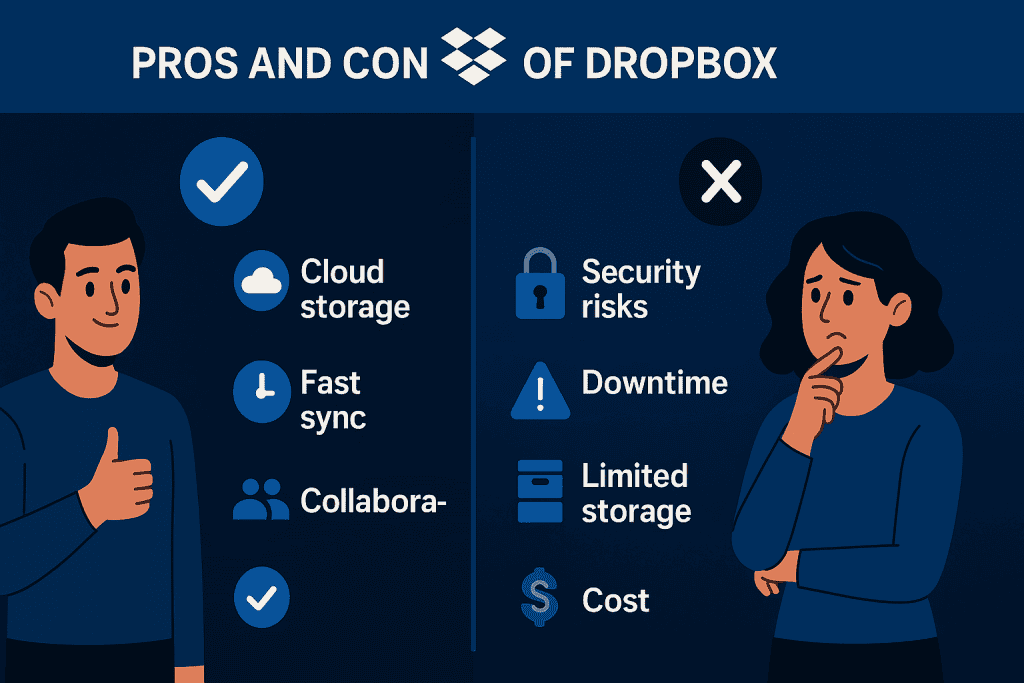I still remember the first time I needed to send a 200 MB presentation to a client halfway around the globe. My email choked, my stress levels spiked, and I spent more time waiting for attachments to upload than refining my talk. Then I discovered Dropbox, a friendly cloud companion that transformed those frantic moments into a breeze. Today, I’ll Walk you through why this service has earned a spot in my toolkit and millions of others’ by making remote sharing as easy as clicking a link.
Overview of Dropbox
Imagine a magic folder that follows you everywhere on your laptop, smartphone, or tablet always up to date, always reliable. That’s the essence of Dropbox:
- Seamless Syncing: Drop a file in your designated folder, and it appears instantly on every connected device.
- Cross-Platform Presence: Whether you use Mac, Windows, Linux, or a smartphone, you’re covered.
- Smart Sharing: Generate shareable links with custom permissions no more juggling attachments.
- Generous Storage Tiers: From free 2 GB accounts for casual users to terabytes for power collaborators.
This overview hints at why I rarely fret about losing photo albums or important spreadsheets again.
Watch the full overview video here:
In-Depth Analysis of Dropbox
When you peel back the layers of the platform, you find thoughtful design and powerful features under the hood.
Design
The moment you open the desktop client or web interface; you feel at home. Minimalist icons, clearly labeled folders, and intuitive drag-and-drop interactions make navigation effortless. I often giggle when my tech-averse aunt asks me, “How did you find that so fast?” because the clean layout hides remarkable sophistication.
Functionality
Under the hood, Dropbox employs delta syncing, transferring only the parts of a document that change, so even a large presentation updates in seconds. During a collaborative brainstorming session last month, my teammates and I edited a 100 MB video script simultaneously, and conflicts were minimal thanks to robust version tracking. Even when connectivity wavered, the automatic resume feature picked up right where it left off.
Security
I’ll admit, handing over personal photos and sensitive documents can be nerve-wracking. Drop box eases that with AES 256-bit encryption at rest and SSL/TLS for data in transit. Two-factor authentication adds another layer of safety so even if someone guesses your password, they can’t break in. For business users, advanced controls like device approvals and remote wipe keep team data under lock and key.
Integration
Beyond its core, Drop box thrives on partnerships. Google Workspace and Microsoft Office files open right in your browser without manual downloads. Project management tools like Trello and Asana link folders directly, streamlining workflows. I’ve even used Zapier to automate archiving client invoices into specific shared folders no manual uploads required.
Dropbox comparison
When I first explored options, Google Drive and OneDrive loomed large. Yet Drop box’s simplicity and reliability won me over. While Drive offers 15 GB free and deep Google app integration, its sync can be choppy on large file sets. OneDrive’s Office synergy is strong, but version history feels limited compared to Dropbox’s generous 180-day rollback. In the end, the devotion of a thriving third-party app ecosystem and a polished user experience set Dropbox apart.
| Feature | Dropbox | Google Drive | OneDrive |
| Free Storage | 2 GB | 15 GB | 5 GB |
| Sync Technology | Block-level (delta) syncing for fast updates | Full-file syncing | Full-file syncing |
| Version History | 180 days (Plus/Professional) | 30 days | 30 days |
| Collaboration Integrations | Microsoft, Google, Slack, Trello | Google Workspace | Microsoft 365 |
| Security | AES 256-bit + two-factor authentication | AES 128-bit + two-factor authentication | AES 256-bit + two-factor authentication |
Pros and Cons of Dropbox

Even my favorite tools have trade-offs. Here’s a quick look:
| Pros | Cons |
| Blazing-fast block-level syncing | Free tier limited to 2 GB |
| Rock-solid encryption and two-factor authentication | Fewer native productivity apps compared to competitors |
| Vast ecosystem of third-party integrations | Can get pricey at higher storage tiers |
| User-friendly interface across platforms | No unlimited storage option (unlike some business rivals) |
Conclusion
After months of daily use, my overall impression is clear: Dropbox strikes a rare balance between power and approachability. It’s best for freelancers juggling multiple devices, small teams collaborating across time zones, or anyone who wants to safeguard precious memories without fuss. If you need a digital vault that simply works, this might be your best bet.
Dropbox Rating
I’ve given Dropbox a solid four out of five stars. While I wish the free tier were more generous and native editing tools more robust, the core experience remains outstanding.
★★★★☆
Check out what others are saying:
FAQ
What makes Dropbox a top cloud storage solution for creative professionals?
Creative professionals often handle large design files, high-resolution photos, and videos. Dropbox’s delta syncing ensures only changed chunks upload, saving time and bandwidth. Version history allows you to roll back to earlier drafts, and selective sync means you only store what you need locally.
How secure is Dropbox for business files?
Dropbox employs enterprise-grade AES 256-bit encryption at rest, SSL/TLS encryption in transit, and supports two-factor authentication. Administrators can enforce device approvals, single sign-on via SAML, and remote wipe to protect sensitive data on lost or stolen devices.
Can I recover deleted files on Dropbox?
Yes. Dropbox’s version history and file recovery features let you restore deleted or overwritten items within 30 days on the free planand up to 180 days on paid tiersso accidental deletions are rarely disastrous.
Resources
- TechRadar. Drop box Cloud Storage Review
- Cloudwards. Dropbox Review
- Experte. Cloud Storage: Dropbox
- Drop box. Features
- Trustpilot. Reviews: Dropbox
